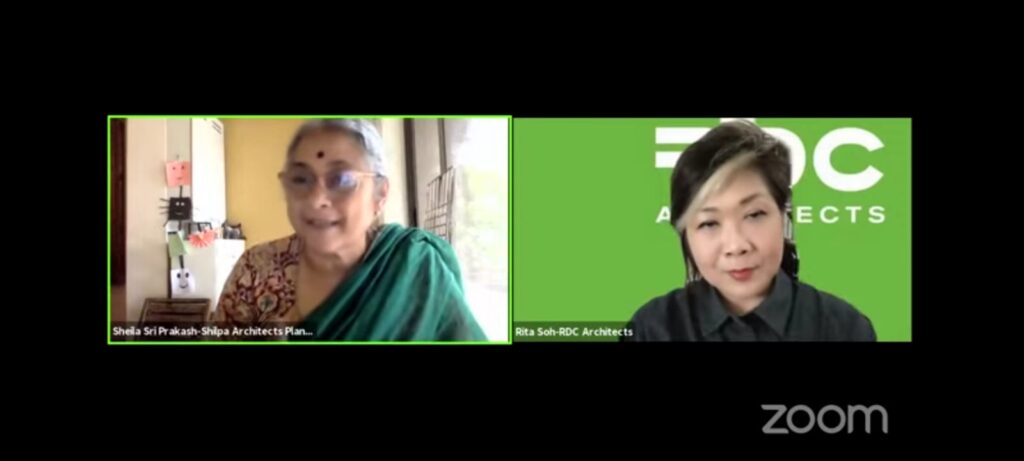
Day one of ADM summit 2021 witnessed an interesting and informative dialogue on ‘Designing IN/FOR/WITH Society’, with RDC Architects Pte Ltd managing director Rita Soh and Shilpa Architects Planners Designers Pvt Ltd founder and chief architect Sheila Sri Prakash. The discussion highlighted how design plays an important role in building society and what are the strategies to be considered while designing different models of the building.
The dialogue session kick-started with Sri Prakash sharing the disastrous scenario of the Chennai floods and how the city is being flooded every year. She held humankind responsible for this kind of calamity as ‘all aquifers, lakes and the low lying areas which are meant to retain water have been filled up because of our urgency to urbanise every free space available.’
Commenting on the development of Singapore and how it has changed over the decades’, Soh said, “Earlier Singapore didn’t have any resources other than human capital. We had imported everything from outside including water which had to be bought from the neighbours. But the country stood together as it needed to survive. We focused on education and believed in training the human capital. Today, you can see how Singapore is a cosmopolitan city and we moved from the third world to a developed country in the last 50 years.”
Talking about the governance and policies followed in Singapore, Soh added, “Singapore has strong rules for planning and especially the Greening Policy founded by our former prime minister makes it mandatory that if you own a piece of land, two meters from the boundary is to be reserved for planting trees. The simple greening policy made Singapore move from ‘Garden city’ to ‘City in the garden’. For water resources, we used to buy water from neighbours and practice desalination. We are slowly moving on to become a self-sustenance country. The pandemic made us realise that we have to rely on ourselves.”
Sri Prakash shared how the pandemic has been a challenge for all the people and how people learned lessons during this tough time. She also raised concerns over global warming and said, “Global warming is real, we are going to see the temperatures going higher, the sea level is going to rise, rains, typhoons, and cyclones are going to be more. We are spiraling outward becoming large, larger, and largest. As an architect, our designs are always people-centric and the fundamental of architecture has always been building for people, creating from the macrospace the microspace of the built environment for people to develop, survive and do better.”
Soh also shared the presentation of her journey, how she built various healthcare facilities and what are the approaches, strategies followed to build socially responsible building areas.

Sharing her approach in design, she said, “Design with empathy for people and embrace sustainability concerns and integrate innovative solutions.”
Soh showcased the plans of remodeling works undergone while working on the National University Hospital. The key strategies followed for renewing the old hospital were that it was renewed with minimum disruptions, new specialty outpatient clinics were injected along with new state of art operating theatres. Wayfinding for seamless connectivity, green courtyards for wellness and art in public spaces was incorporated.
The design objectives followed while remodeling were sustainability, regenerative healthcare campus with nature as the prime focus, integrated patient-centric care model, seamless quality of care, and innovative age-friendly designs.
While building healthcare facilities, that had to embrace ideas like naturally ventilated space, greenery, smart metering and control to reduce waste, use of green products, natural lighting, Low-E-DGU, PV cells, and more.
Highlighting reciprocity is the main philosophy of design. Sri Prakash expounded, “Reciprocity has been the philosophy of my design when I started Shilpa back in 1980, and I still feel that it is very relevant and it is my mantra till now. Only the scale of the projects has increased and complexities have increased because the stakeholder’s group has become much larger. We are answerable to a larger group of people.”
Commenting on Singapore’s constant urban renewal and public housing, Soh said, “In Singapore, public housing has been followed for more than 60 years and one can see different decades of design and transformation. Some of the older buildings were brought down and some of the buildings were renewed by incorporating new designs and as the population increases, we have to consider the spacing of the buildings. Some apartments need to rise high to accommodate the major population.”
Sri Prakash raised concerns over how the residential apartments are built with 30-40 floors and they are all housed over parking lots. These parking lots are invariably about half of residential development. Responding to Sri Prakash’s query about how the parking lots are being modified in Singapore, Soh said, “In Singapore, we have mandated that only less number of car parks will be provided and a lot of our car parks have been converted to urban farming plots. In order to control the car transports, we have to find alternative automotive transport. We are working on it intensively.”
Concluding the session, Sri Prakash said, “In India, we should follow from Singapore the tenacity of the purpose. The tenacity to make things happen and the enforcement which makes it happen is lacking in our country and therefore we are meandering towards becoming a developed country. But I believe that slowly but surely we will get it.”

